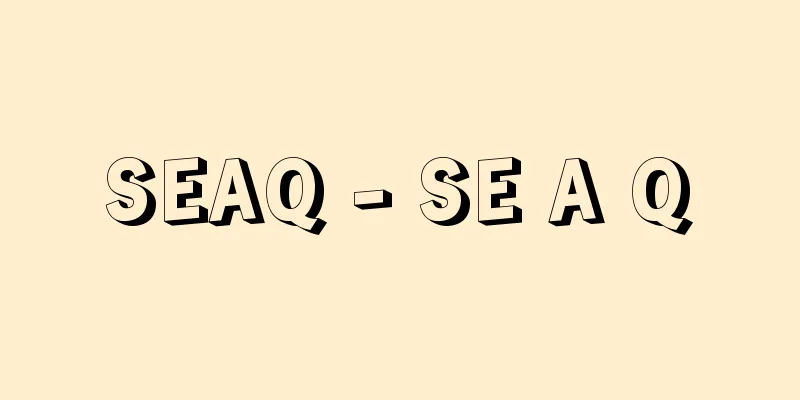Base issue - crazy issue

|
This refers to the problems that arise from the existence of military bases (U.S. military and Self-Defense Forces), damage and accidents that arise from their establishment, maintenance, and operation (operations, exercises, training, etc.), as well as the problems that arise when the maintenance and operation of the bases conflict with local life, private rights, general administrative policies, and general laws and regulations. [Shigeo Hayashi] Causes and Examples of Base IssuesThe base issue was not a social problem before World War II, but after the war it became a worldwide problem. The background to this was the formation of a military alliance and the stationing of foreign troops due to the intensifying conflict between the United States and the Soviet Union, as well as the increasing danger caused by the rapid development of weapons such as nuclear weapons. In particular, the main reasons why base issues occur so frequently in Japan and often become major political and social issues are as follows: (1) The Japanese Constitution and the legal order based on it (constitutional system) do not foresee the possession of an army, but the Japan-U.S. Security Treaty, which requires the stationing of U.S. troops, and the various agreements and special domestic laws based on it (security legal system), grant the U.S. military various privileges and powers. For this reason, Japan is in a unique political situation, unprecedented in the world, where two fundamentally opposing basic legal systems continue to coexist and conflict with each other. (2) Japan’s geographical location occupies an important position in the U.S. strategic hierarchy, and there are many important U.S. military bases in its small territory. (3) The Japan-U.S. Status of Forces Agreement, which stipulates the privileges and powers of U.S. military forces, has a very strong element of subordination compared to other countries that have military treaties with the United States. Representative examples of base problems include land issues caused by the establishment and expansion of bases, infringement of membership rights, damage to agriculture and fisheries caused by training, military aircraft crashes, damage caused by objects falling from military aircraft, accidents and damage caused by the transportation (railroad, truck, pipeline) and storage of hazardous materials such as ammunition and jet fuel, unexploded ordnance accidents, forest fires, contamination of water sources, noise problems caused by military aircraft and live ammunition firing, problems with the introduction of nuclear weapons, radioactive seawater contamination caused by nuclear submarines calling at ports, the leakage of waste oil, human waste, and sewage from bases, traffic accidents caused by military vehicles, crimes committed by U.S. soldiers (murder, robbery, assault and battery), human rights violations of base workers, restrictions on the installation and use of obstructions that cause radio waves (buildings, vehicles, electrical equipment), problems with the use of returned base sites, and problems impeding urban planning by local governments. In particular, Okinawa, where 75% of U.S. military bases are concentrated in terms of area, has seen a large number of base problems even after reversion. During the occupation and the 1950s after the peace treaty, there were many cases of land problems due to the US military's forced confiscation and the establishment and expansion of bases, direct and indirect damage to agriculture and fishing, criminal acts by US soldiers around bases, and moral and educational problems, and these cases were concentrated in farming and fishing villages. Later, with the withdrawal of US ground forces, the number of cases gradually decreased, and instead, base problems surrounding the strengthened Self-Defense Forces began to occur. Since the 1960s, with the progress of urbanization around bases, military aircraft crashes, noise problems, the transportation of hazardous materials such as ammunition and jet fuel within cities, and problems with the use of former base sites became major social issues. In the 1990s after the Cold War, in response to changes in US strategy, ultra-low altitude flight exercises by Navy and Marine Corps aircraft were forced to be carried out in various places as conflict response exercises, and the damage was concentrated in mountainous areas and small and medium-sized cities rather than around large cities. In particular, during the Korean War and the Vietnam War, when the frequency of dangerous use of military bases increased dramatically, base problems arose and intensified, not only increasing public anxiety but also giving rise to serious problems that could not be foreseen in peacetime, such as the problem of flammable well water caused by the seepage of large amounts of waste oil from air force bases into the groundwater, the problem of transporting damaged weapons and other items directly from unsanitary battlefields without quarantine, the frequent transportation of large, heavy items such as tanks and armored vehicles, and dangerous materials such as jet fuel within urban areas, and the problem of establishing field hospitals and special comfort facilities. [Shigeo Hayashi] The reality of damage caused by the bases and the issue of compensationThe damage caused by the bases is diverse, and extends from the lives and health of the local residents to all areas of their lives, such as production, labor, education, and transportation, and these damages are intertwined and threaten and destroy their very lives. The compensation laws are also complicated, but since their primary objective is to maintain the functions and stable use of the bases, there are almost no restrictions on the source of the damage itself, and only a portion of the damage suffered by the residents is provided with legal relief after the fact. In addition, the government provides subsidies for construction work to prevent various types of damage (roads, rivers, agricultural, forestry, and fishery facilities, soundproofing for schools, hospitals, and social welfare facilities) and subsidies for facilities to stabilize civil life (roads, community centers, daycare centers, etc.) in accordance with the Law for the Improvement of Living Environments Surrounding the Bases. The aim is to flexibly apply the subsidies to change the local governments and residents surrounding the bases from opposing the bases to actively supporting and cooperating with them, and to ensure the stable use of the bases. Regarding the issue of noise from air bases, residents living near air bases suffer from noise levels more than double the residential area standards set by the Cabinet Decision on Environmental Standards for Noise, and suffer from multiple damages in terms of education, health, and daily life. Meanwhile, the countermeasures taken by the US military and Self-Defense Forces bases, the perpetrators, are limited to the installation of silencers for engine tests, and there are virtually no measures to regulate the source of noise. For the victims, within the designated noise zones, assistance is provided for soundproofing work for about one room per house, compensation is provided within the budget for those who have relocated or removed their homes, and non-residential zones are created around the bases. In addition, assistance is provided for the installation of noise telephones, broadcast reception fees are reduced, and part of the costs are subsidized as a favor for soundproofing work in schools, hospitals, nurseries, and nursing homes in surrounding municipalities, to ease the dissatisfaction of surrounding residents and municipalities. In this situation without any measures to regulate noise sources, lawsuits such as the Yokota Air Base noise lawsuit, the Kadena Air Base noise lawsuit, and the Komatsu Air Base Phantom deployment injunction lawsuit were filed, demanding "give back our quiet nights." Compensation for past damages has been largely established, but requests to suspend flights have been rejected. In 1998, the first "Draft Law for Compensation for Damages Caused by U.S. Military Personnel in Japan" was created, and there are also moves to legislate a compensation system. [Shigeo Hayashi] Criminal cases involving American soldiers and jurisdictionThe number of illegal acts by American soldiers (assaults, injuries, traffic accidents, plane crashes, etc.) recorded in statistics alone is 44,166 (508 deaths) in the "official line of duty" between 1952 (Showa 27) and 1994 (Heisei 6) (not including Okinawa before reversion). However, the US side has never held a military trial. The US military has primary jurisdiction over official duties, and Japan has primary jurisdiction over off-duty. However, even if the Japanese authorities make an arrest, the suspect must be handed over to the US military not only when it is clear that the US military has primary jurisdiction, but also when it is questionable whether the suspect was on official duty. Therefore, even in cases of shooting and sniping, if the incident occurs at a training ground, Japan cannot exercise jurisdiction due to the official duty certificate issued by the US military, and the punishment of the perpetrator is often left unresolved. In Japan, there is no example of a US military court martial in Germany, where a US soldier who raped a woman was sentenced to death. It has been reported that US military personnel in Japan are the world's largest victims of sexual crimes in military courts (Pacific Stars and Stripes, October 9, 1995), but all cases have been treated as minor offenses and the punishments have been extremely light. In September 1995, when a US soldier raped a young girl in Okinawa, a protest movement was started throughout the prefecture, which developed into a large-scale rally of the prefecture's residents (in this case, two of the three defendants were sentenced to seven years in prison and the other to six years and six months in prison at the Naha District Court in March 1996). Even if a crime committed outside of official duties falls under Japanese jurisdiction, the detainee cannot be detained unless there is a legitimate reason and necessity for detention, and if the detainee is already in the hands of the U.S. military, he or she will not be handed over until indictment. The attitude of the Japanese prosecutor's office and courts toward crimes committed by American soldiers is servile, and the rate of prosecution is low, while the rate of suspended sentences is higher than that of Japanese soldiers. Even for shooting someone to death, the sentence is light, such as three years in prison suspended for four years (Girard case), and for running someone over, the fine is 30,000 yen (Kasai case). Compensation for damages caused by torts is provided for by the Japan-U.S. Status of Forces Agreement, whether the crime was committed on or off official duties, and compensation and consolation money are paid, but the assessment is kept low because the victim is also considered to be negligent. Currently, tragic crashes are also covered by the Defense Facilities Administration Agency's condolence payment system. However, there have been cases where a lawsuit was filed against the government seeking damages, and the amount was more than double the total amount of the initial U.S. military consolation money and government consolation money (Kasai case). Unlike the U.S. military, compensation for damages caused by the torts of the Self-Defense Forces is provided by the State Compensation Act and civil law. In the collision between the Maritime Self-Defense Force submarine "Nadeshiko" and the pleasure boat "Daiichi Fujimaru" (Nadeshiko Incident, 1988), which occurred after the Shizukuishi Incident (1971) in which an All Nippon Airways plane collided with an Air Self-Defense Force plane, the Local Marine Accident Inquiry, the High Marine Accident Inquiry, the Yokohama District Court Criminal Trial, and the Tokyo High Court Administrative Trial for the Annulment of the High Marine Accident Inquiry's Judgment, found that the Nadeshiko was responsible for the collision. However, as in the Shizukuishi Incident, the sentence was suspended. [Shigeo Hayashi] "Local Governments and Military Bases" by Shoichiro Sato (1981, Shinnihon Shuppansha)" ▽ "Japan's Military Bases" edited by the National Liaison Conference for Base Measures (1983, Shinnihon Shuppansha)" ▽ "Verification of the Nadashio Submarine Incident" edited by Shunichi Tagawa (1994, Touken Shuppan) [Reference items] | | | | JapanSource: Shogakukan Encyclopedia Nipponica About Encyclopedia Nipponica Information | Legend |
|
軍事基地(米軍・自衛隊)の存在とその設置・維持およびその運用(作戦行動、演習、訓練など)から生じる被害、事故、さらに基地の維持・運用などが、地域生活、私権、一般行政施策、一般法令などと矛盾するために起こる諸問題をいう。 [林 茂夫] 基地問題の原因と事例基地問題は第二次世界大戦前には社会問題化することはなかったが、戦後には世界的に多発した。その背景には、米ソの対立激化による軍事同盟の形成と外国軍隊の駐留、さらに核兵器など兵器の急速な発達による危険性の増大という事情がある。 なかでも日本で基地問題が多発し、しばしば大きな政治問題、社会問題となる主たる理由は以下の3点にある。 (1)日本の憲法とそれに基づく法秩序(憲法体系)は軍隊の保持を予定していないが、米軍駐留を義務づけた日米安全保障条約とそれに基づく諸協定・国内特別法(安保法体系)では、米軍に軍隊のもつ各種の特権・権能などを認めている。このため、日本は根本的に相対立する二つの基本法体系が併存・対立し続けているという、世界に例のない特殊な政治状況にある。 (2)日本がその地理的位置から米戦略上重要な地位を占めるため、重要な米軍基地が狭い国土に数多く存在する。 (3)米軍の特権・権能を規定した日米地位協定などが、アメリカと軍事条約を結んでいる諸外国に比べ、きわめて従属的要素が強い。 基地問題の代表的事例を列挙すれば、基地新設・拡張による土地問題、入会(いりあい)権侵害問題、演習による農漁業の被害、軍用機墜落事故、軍用機からの落下物被害、弾薬・ジェット燃料など危険物の輸送(鉄道・トラック・パイプライン)や貯蔵による事故や被害、不発弾事故、山林火災、水源地汚染、軍用機や実弾射撃による騒音問題、核兵器持込み問題、原潜寄港による放射能海水汚染、基地内からの廃油・屎尿(しにょう)水・汚水の流出、軍用車両による交通事故、米兵による犯罪(殺人・強盗・暴行傷害)、基地労働者の人権侵害問題、電波障害となる妨害物(建物・車両・電気機器)の設置・使用の制限問題、返還基地跡地利用問題、自治体の都市計画阻害問題などがある。とくに、面積で米軍基地の75%が集中している沖縄は、復帰後も各種基地問題が多発している。 占領時代と講和後の1950年代には、米軍による実力接収や基地新設・拡張に伴う土地問題、農漁業における直接間接被害、基地周辺における米兵の犯罪行為、風紀・教育問題などの事例が多く、発生地域も農漁村に集中していた。その後、米地上軍の撤退によって漸減し、かわりに増強された自衛隊をめぐる基地問題が起こるようになった。1960年代以降は基地周辺の都市化の進行に伴い、軍用機墜落事故、騒音問題、弾薬・ジェット燃料など危険物の市街地内輸送、さらに基地跡地利用問題などが大きな社会問題となった。冷戦後の1990年代は、米戦略の変化に対応して海軍・海兵隊機による紛争対処演習としての超低空飛行演習が各地で強行されており、その被害は大都市部周辺よりも、山間部周辺の地域や中小都市に集中している。 とくに基地の危険な使用頻度が激増した朝鮮戦争、ベトナム戦争時には、基地問題が多発、激化し、国民の不安を高めたばかりか、平時には予想できぬ深刻な問題も起こった。空軍基地から出る大量の廃油の地下水浸透による燃える井戸水問題、破損兵器などを不衛生な戦場から検疫なしに直接搬入する問題、戦車・装甲車などの大型重量運搬物、ジェット燃料などの危険物の頻繁な市街地内輸送問題、野戦病院や特殊慰安施設の設置問題などがそれである。 [林 茂夫] 基地被害の実態と補償問題基地被害の態様は多種多様であり、周辺住民の生命・健康から、生産、労働、教育、交通など生活のあらゆる分野に及び、それらが複合的に絡み合って、生活そのものを脅かし破壊している。したがって、それに対する補償諸法令もまた複雑だが、その基本は基地の機能保持と安定使用を第一義としているため、被害発生源そのものに対する規制はほとんどなされず、住民の受けた被害の一部分に対し、事後的に法的救済がなされるにすぎない。また政府は基地周辺生活環境整備法により、各種障害防止のために、障害防止工事助成(道路、河川、農林漁業用施設など、学校・病院・社会福祉施設などの防音)、民生安定施設助成(道路、公民館、保育所など)を行っている。そのねらいは、補助金の弾力的運用によって、基地周辺自治体と住民を、基地に反対せず、むしろ積極的に支持・協力するように変えて、基地の安定使用を図るところにある。 基地騒音問題についてみれば、航空基地周辺の住民は「騒音に係る環境基準について」(閣議決定)が定める住宅地区基準の倍以上の騒音のもとで生活し、教育面、健康面、生活面にわたる複合的な被害を受けている。一方、これに対する対策は、加害者側の米軍・自衛隊基地に対しては、エンジン・テスト用の消音装置の設置程度で、音源規制対策は皆無に等しい。被害者側に対しては、指定された騒音区域内では、1住宅1室程度の住宅防音工事の助成、住宅の移転・除去者に対する予算の範囲内での補償がなされ、基地周辺に非居住地帯造出が基本となっている。また騒音用電話機設置事業への補助、放送受信料減免措置のほか、周辺自治体の学校、病院、保育所、老人ホームなどの防音工事に恩恵的に費用の一部を補助するなど、周辺住民・自治体の不満緩和策がとられている。このような音源規制策なしの状況のなかで「静かな夜をかえせ」の横田基地騒音訴訟、嘉手納(かでな)基地騒音訴訟、小松基地ファントム配備差止め訴訟などが起こされた。過去分の損害補償についてはほぼ定着したが、飛行差し止め要求などは拒否されている。1998年(平成10)には、初めて「在日米軍人等による損害賠償法(案)」がつくられ、補償制度の立法化への動きもある。 [林 茂夫] アメリカ兵の犯罪事件と裁判権アメリカ兵による不法行為(暴行傷害、交通事故、墜落事故など)は統計にのっただけで、講和後の1952年(昭和27)から1994年(平成6)までに「公務中」の事件・事故だけで4万4166件(死者は508人)に及ぶ(復帰前の沖縄含まず)。だがアメリカ側は軍事裁判を一度も開いていない。公務上のものは米軍側に第一次裁判権があり、公務外のものは日本側に第一次裁判権がある。だが、日本側当局が逮捕しても、米軍側に第一次裁判権が属することが明白な場合はもちろん、公務中かどうか疑問の場合も被疑者を米軍側に引き渡さねばならぬことになっているため、射殺事件や狙撃(そげき)事件でも、演習場で起きたときは、米軍の発行した公務証明によって日本が裁判権を行使できず、犯人処罰がうやむやとなるケースが多い。日本では、婦女暴行したアメリカ兵に死刑の判決を下したドイツ駐留の米軍軍法会議のような例はない。在日米軍が性犯罪で軍法会議の裁判ざたになることは世界で突出していると報じられているが(『パシフィック・スターズ・ストライプス』、1995年10月9日)、すべて軽犯罪扱いで、きわめて軽くされている。1995年9月、沖縄米兵少女暴行事件が起きるや、全県で抗議運動が起こされ、大規模な抗議の県民総決起大会開催へと発展した(この事件では、1996年3月那覇地裁で3人の被告のうち2人に懲役7年、1人に懲役6年6か月の実刑判決が下された)。 公務外の犯罪で日本側の裁判権に属する場合でも、拘留の正当な理由と必要性がなければ身柄は拘束できないし、身柄がすでに米軍の手中にあるときは起訴まで引き渡されない。アメリカ兵の犯罪に対し、日本の検察庁、裁判所の態度は卑屈で起訴率が低く、一方、執行猶予率が日本人の場合より高い。射殺しても懲役3年執行猶予4年(ジラード事件)、轢殺(れきさつ)でも罰金3万円(笠井(かさい)事件)など刑が軽い。不法行為による損害の補償は、日米地位協定により、公務上か公務外かで、それぞれ補償金、慰謝料が出るが、その査定は被害者にも過失があるとして低く抑えられている。悲惨な墜落事故も防衛施設庁の見舞金制度で済まされているのが現状である。だが、国を相手に損害賠償請求訴訟を起こし、当初の米軍慰謝料と政府見舞金の合計額の倍以上をかちとったケースもある(笠井事件)。自衛隊の不法行為による損害に対する救済は、米軍と違い国家賠償法、民法による。全日空機と航空自衛隊機が衝突した雫石(しずくいし)事件(1971)に次いで起きた海上自衛隊の潜水艦「なだしお」と遊漁船「第一富士丸」との衝突事件(なだしお事件、1988)では、地方海難審、高等海難審、横浜地裁刑事裁判、高等海難審判決取消し請求の東京高裁行政裁判で、「なだしお」側に衝突原因ありとされたが、雫石事件と同じく、執行猶予となっている。 [林 茂夫] 『佐藤昌一郎著『地方自治体と軍事基地』(1981・新日本出版社)』▽『基地対策全国連絡会議編『日本の軍事基地』(1983・新日本出版社)』▽『田川俊一編著『検証・潜水艦なだしお事件』(1994・東研出版)』 [参照項目] | | | |出典 小学館 日本大百科全書(ニッポニカ)日本大百科全書(ニッポニカ)について 情報 | 凡例 |
Recommend
Isanglan - Isanglan
…the name of a group of animal epics that emerged...
garbha-gṛha (English spelling) garbhagrha
In Bengal and Orissa, it is also called deul. The...
Reverse extrusion
...Products made by extrusion include aluminum sa...
Shirakami Mountains
This mountainous area, which was registered as a W...
Ohmmeter - Ohmmeter
Also called an ohmmeter. An instrument for easily ...
Blue tide - Aoshio
When a strong wind blows from land to sea, surface...
Orimono - vaginal discharge
...a person with visual impairment. The word &quo...
Oshimaso - Oshima no Sho
…The area is on a steep terrain with the highest ...
Sialkot
A city on the left bank of the Chenab River in nor...
Gills Lagash - Gills Lagash
…The first urban civilization, mainly composed of...
External Perception
...And this is also the basis for ontological dua...
Sravanabelgola (English spelling)
Jain ruins in the Mysore region of Karnataka, sout...
Carrot and stick - Carrot and stick (English spelling) mit Zuckerbrot und Peitsche
A political strategy. The carrot means to win the ...
Davis Cup
A silver trophy awarded to the winner of the men&#...
Wind God - Fuushin
The god of wind. In ancient China, he was called ...









